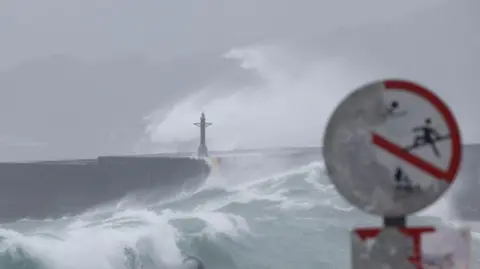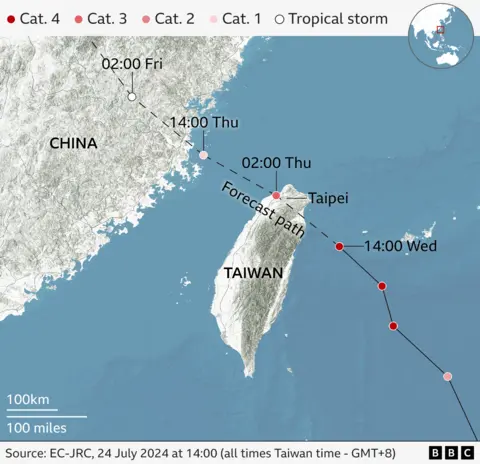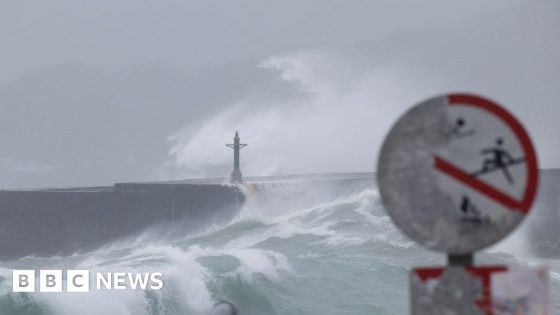 Reuters
ReutersTyphoon Gaemi has made landfall on Taiwan’s east coast, bringing gusts of around 240kmh (150mph).
Gaemi, which has landed near the city of Hualien, is expected to be the most powerful storm to hit the island in eight years.
One woman died after she was hit by a tree.
Taiwan’s largest annual military drills have been cancelled, along with almost all domestic flights and more than 200 international flights, according to the transport ministry.
Authorities are warning one of biggest risks comes from the typhoon’s potential to cause landslides and flash flooding, especially on mountainsides destabilised by a large earthquake in April.
On its way to Taiwan, Gaemi also brought relentless rains to large swathes of the Philippines, with floods turning streets into rivers in the capital Manila.
The typhoon is seeing winds of up to 240kmh (150 mph), the equivalent of a category four hurricane in terms of wind strength and destructive potential.
The government has declared Wednesday a typhoon day, suspending work and classes across the island except for the Kinmen islands.
However, chip manufacturing giant TSMC told the BBC that their plants would maintain normal operations.
The storm was originally expected to hit further north, but the mountains of northern Taiwan steered the typhoon slightly south towards the city of Hualien.
The typhoon is expected to weaken as it tracks over the mountainous terrain of Taiwan before re-emerging in the Taiwan Strait towards China.
A second landfall is expected in Fujian Province, China, later on Thursday. 300mm of rain is forecast there and is expected to lead to extensive flooding as the typhoon moves inland and breaks up.
Predicted path of Typhoon Gaemi

Despite the very strong winds, officials say the main threat from Gaemi is from the huge amount of moisture it is carrying.
The island’s Central Weather Administration has issued a land warning for all of Taiwan, expecting wind and rain to be at their worst on Wednesday and Thursday.
Taiwanese authorities are warning that between one and two metres of rainfall can be expected across the central and southern mountains of the island in the next 24 hours.
In the capital Taipei, shelves in supermarkets were left bare on Tuesday evening as people stocked up ahead of what are expected to be sharp rise in prices after the typhoon passes.
The threat of the typhoon has also forced the government to call off parts of its planned week-long Hang Kuang military drills on Tuesday and Wednesday, although they had repeatedly said the drills would be “the most realistic ever”.
Gaemi and a southwest monsoon also brought heavy rain on Wednesday to the Philippine capital region and northern provinces. Work and classes have been halted there while stock and foreign exchange trading were suspended.
Metro Manila, home to nearly 15 million people, was placed under a state of calamity as rivers and creeks overflowed.
Footage circulating on social media showed small cars floating in chest-deep waters and commuters trapped on the roofs of buses.
The state weather bureau said the rains, which are typical at this time of the year, could persist until Thursday.
Source Agencies



